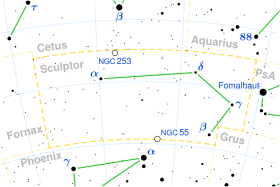Iota Sculptoris
| Observation data Epoch J2000 Equinox J2000 | |
|---|---|
| Constellation | Sculptor |
| Right ascension | 00h 21m 31.19832s[1] |
| Declination | −28° 58′ 53.2929″[1] |
| Apparent magnitude (V) | 5.18[2] |
| Characteristics | |
| Spectral type | K0III[3] |
| U−B color index | +0.84[4] |
| B−V color index | +1.00[5] |
| Astrometry | |
| Radial velocity (Rv) | +20.60[6] km/s |
| Proper motion (μ) | RA: +32.76[1] mas/yr Dec.: -72.01[1] mas/yr |
| Parallax (π) | 9.87 ± 0.41[1] mas |
| Distance | 330 ± 10 ly (101 ± 4 pc) |
| Absolute magnitude (MV) | 0.16[2] |
| Details | |
| Mass | 2.94[7] M☉ |
| Radius | 12.28[7] R☉ |
| Luminosity | 97[7] L☉ |
| Surface gravity (log g) | 2.48[8] cgs |
| Temperature | 5,020[7] K |
| Metallicity [Fe/H] | +0.09[2] dex |
| Rotational velocity (v sin i) | 3.1[9] km/s |
| Other designations | |
| Database references | |
| SIMBAD | data |
Iota Sculptoris (ι Scl) is a class K0III[3] (orange giant) star in the constellation Sculptor. Its apparent magnitude is 5.18[2] and it is approximately 330 light years away from Earth based on parallax.[1]
References
- 1 2 3 4 5 6 Van Leeuwen, F. (2007). "Validation of the new Hipparcos reduction". Astronomy and Astrophysics. 474 (2): 653. arXiv:0708.1752. Bibcode:2007A&A...474..653V. doi:10.1051/0004-6361:20078357. Vizier catalog entry
- 1 2 3 4 Anderson, E.; Francis, Ch. (2012). "XHIP: An extended hipparcos compilation". Astronomy Letters. 38 (5): 331. arXiv:1108.4971. Bibcode:2012AstL...38..331A. doi:10.1134/S1063773712050015. Vizier catalog entry
- 1 2 Houk, N. (1982). "Michigan Catalogue of Two-dimensional Spectral Types for the HD stars. Volume_3. Declinations -40_ƒ0 to -26_ƒ0". Michigan Catalogue of Two-dimensional Spectral Types for the HD stars. Volume_3. Declinations -40_ƒ0 to -26_ƒ0. Bibcode:1982mcts.book.....H.
- ↑ Mermilliod, J. C. (2006). "VizieR Online Data Catalog: Homogeneous Means in the UBV System (Mermilliod 1991)". VizieR On-line Data Catalog: II/168. Originally published in: Institut d'Astronomie. 2168. Bibcode:2006yCat.2168....0M. Vizier catalog entry
- ↑ Mallama, A. (2014). "Sloan Magnitudes for the Brightest Stars". The Journal of the American Association of Variable Star Observers. 42: 443. Bibcode:2014JAVSO..42..443M. Vizier catalog entry
- ↑ Wilson, R. E. (1953). General Catalogue of Stellar Radial Velocities. Carnegie Institution for Science. Bibcode:1953GCRV..C......0W. LCCN 54001336.
- 1 2 3 4 Jones, M. I.; Jenkins, J. S.; Rojo, P.; Melo, C. H. F. (2011). "Study of the impact of the post-MS evolution of the host star on the orbits of close-in planets". Astronomy & Astrophysics. 536: A71. arXiv:1110.6459. Bibcode:2011A&A...536A..71J. doi:10.1051/0004-6361/201117887. Vizier catalog entry
- ↑ Allende Prieto, C.; Lambert, D. L. (1999). "Fundamental parameters of nearby stars from the comparison with evolutionary calculations: Masses, radii and effective temperatures". Astronomy and Astrophysics. 352: 555. arXiv:astro-ph/9911002. Bibcode:1999A&A...352..555A. Vizier catalog entry
- ↑ De Medeiros, J. R.; Alves, S.; Udry, S.; Andersen, J.; Nordström, B.; Mayor, M. (2014). "A catalog of rotational and radial velocities for evolved stars". Astronomy & Astrophysics. 561: A126. arXiv:1312.3474. Bibcode:2014A&A...561A.126D. doi:10.1051/0004-6361/201220762. Vizier catalog entry
This article is issued from
Wikipedia.
The text is licensed under Creative Commons - Attribution - Sharealike.
Additional terms may apply for the media files.
